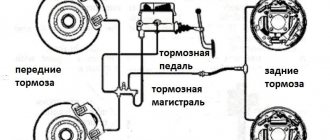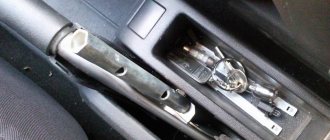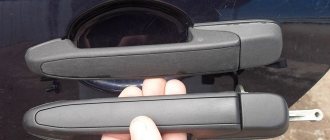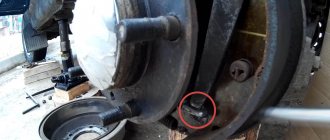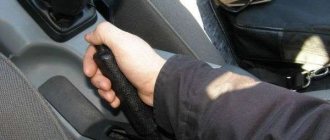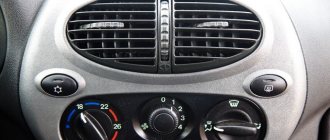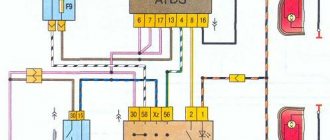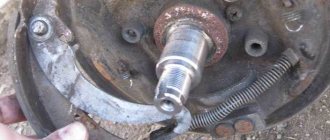Lada Kalina is equipped with a classic version of a cable-driven parking brake. The parking brake allows you to lock the vehicle in a stationary position on a flat surface or slope. The hand brake can be used during emergency braking. The “handbrake” is able to replace the foot brake if the latter fails. In this article, we will tell you how to tighten the handbrake on Kalina.
Handbrake diagnostics
To diagnose the parking brake yourself, use the inspection hole. On automobile forums, it is advised to develop the cable when it is dirty and snagged, but this measure is ineffective. Don't skimp or change, your safety is more important.
Some European countries have a fine for drivers driving a vehicle with a faulty handbrake. We don't have that yet.
When the lever is tightened, clicks are heard. With the handbrake adjusted, there should be from two to four. In this position, the wheels should not spin. If there are fewer or more clicks, proceed to adjusting the handbrake or replacing the rod and drives.
What causes problems
The main reason for failure is weak cable tension. Somewhat less frequently, the problem occurs due to wear on the brake linings. They tend to gradually wear off. Sometimes the handbrake does not function properly because there is too much space between the drums and the shoes.
In each specific case, you first have to repair the damaged element of the brake system, and only then tighten the handbrake cable. Ignoring the root cause can lead to unpredictable consequences.
Setting up the handbrake on Kalina hatchbacks and station wagons
After making sure that all components of the brake system are normal, you can begin adjusting. Goal: to ensure that the rear wheels are completely locked with 2–4 clicks of the lever lock.
- If the blocking occurs faster, you need to lengthen the cable a little and check again.
- If you have to expect five or more clicks, you should shorten it, selecting the desired length experimentally.
This work can be done independently, without an assistant, but you will need an overpass or inspection hole. You will also need:
- two 13mm wrenches (open-end and socket);
- wrench with extension and heads for 10 and 13;
- liquid key type product (WD-40).
Tools needed for setup - gallery
Open-end wrench 13 Socket wrench 13 Wrench with extension and heads 10 and 13 Liquid wrench WD-40
The procedure is simple:
- After placing the car on the overpass, engage first or second gear. Place wheel chocks or bricks under the front wheels.
- Treat all threaded connections with WD-40 10-15 minutes before starting work. This will make it easier to unscrew the nuts without damaging the threads.
- Lower the handbrake lever.
- Remove the muffler from the rubber pads.
To adjust the handbrake you need to remove the muffler from the rubber pads
- Unscrew the four bolts of the protective screen (10mm head) and remove it.
Unscrew the protective screen from the four attachment points
Under it there is a parking brake rod, an equalizer, and two brake cables (left and right).
Under the protective screen there is a handbrake rod for Kalina
- Loosen the additional nut on the rod with a 13-mm spanner, holding the main one with an open-end wrench. To make adjustments you will need the main nut on the rod. If you need to shorten the cable and, accordingly, achieve earlier wheel locking, the nut should be tightened; If necessary, increase the length by unscrewing.
- After every 3–5 turns of the nut, check the operation of the handbrake, ensuring that complete locking occurs with 2–4 clicks of the latch.
- With the rear wheels hanging, check the brakes. When the handbrake is raised, the wheels should be blocked, and when lowered, they should rotate smoothly without touching the pads. If everything is ok, tighten the locknut.
- Reinstall the protective shield and muffler. Tighten the nuts on the fasteners carefully, otherwise the threads may be stripped.
- Check the parking brake on a 25% slope! If the car rolls away, the cable needs to be replaced.
We recommend: Advantages of ordering a car battery from a local company rather than from network companies
The design of the parking brake and the procedure for adjusting it are similar for all models of the Kalina 1 (sedan, hatchback, station wagon) and Kalina 2 (hatchback and station wagon) family. The Kalina 2 Sport stands apart, having more modern disc brakes at the rear instead of drum brakes. You need to check the pads of a Kalina Sport car like this:
- Raise the car with a jack and remove the wheel.
- Check to see if wear is even across the entire visible part of the disc. If not, you should go to a car repair shop, where they will carry out detailed diagnostics.
- Inspect the brake pads through the inspection hole. If installed parts appear thinner than new, replacement is required.
Main works
Any work related to the repair and maintenance of a car, as a rule, requires the use of a certain set of tools, and tensioning the handbrake on Kalina is no exception to the general rules. Tools:
- keys No. 10 and No. 13;
- head with extension No. 13;
- ratchet.
Of course, you can get by with the minimum, for example, two open-end wrenches, but such a tool will not be very convenient to work with, and it will not speed things up.
Of course, you can simply jack up the car and place it on trestles or blocks. This, however, is not entirely safe, and working this way is not very convenient. The best solutions are:
- Inspection ditch.
- Lift.
- Overpass.
In order to tighten the handbrake on Kalina, you need to drive the car onto an overpass or inspection ditch (the car owner hardly has a lift). Further sequence of actions:
- Engage first gear and fully release the parking brake.
- While under the car, you first need to use a 10mm wrench to unscrew all four bolts that secure the protective cover of the device.
- To make it more convenient to work, you need to remove the rubber suspension from the muffler mounting hook - a “carrot” in driver’s slang.
- The protective cover must be moved forward, providing access to the adjustment unit, which serves to tighten the handbrake on Kalina. At service stations, mechanics use a special long wrench with a swivel joint so as not to remove the muffler from the suspension and speed up the whole process.
- Then you need to fix the adjusting nut with an open-end wrench No. 13. Next, use a 13mm head to unscrew the locknut, which ensures reliable fixation of the adjustment. By turning the adjusting nut in the direction of tightening, tighten the cable. From time to time you need to check the number of clicks of the tensioner ratchet. Having brought the number of such to four or five, it is worth checking the handbrake in action.
- Having jacked up the rear wheels, you need to turn each one in turn. In this case, the brake drums should rotate freely, slightly touching the brake drum - this will be audible - and when tightening the cable, it is not possible to completely rotate the wheels by hand. Or you can try, by lowering the rear wheels and removing the jack, to move the car with a taut cable - all these methods have already been described above.
If everything is in order, then you need to tighten the locknut with the head, while holding the adjusting nut so that the adjustment does not go astray.
After this, the casing is put in place.
When tightening the nuts securing the casing, this should be done without excessive fanaticism, so as not to tear off the studs that are attached to the bottom of the body. They are spot welded and may not withstand too much force.
Before tightening the nuts, you should not forget that you need to place one locking washer under each of them - this will prevent self-unscrewing.
It happens that, despite the correct actions, it is not possible to adjust the parking brake. Possible reasons in this case are the following:
- wear of the brake pads of the rear wheels;
- wear of the brake drums of the rear wheels;
- extreme wear of the cable or its jamming.
In order to understand the reason, you need to jack up the rear wheels again, putting the car in first gear.
After removing the drums, make sure that the brake pads and drums are in good condition or not. The thickness of the linings should be at least four millimeters, and the wear of the drums should not be excessive.
If everything is fine here, then the handbrake cable will need to be replaced.
Verification methods
The handbrake on most cars should hold the car on a 25 percent grade, provided it produces three to five ratcheting clicks when tightened.
If there are more of them, then this is a sure signal that it is time to adjust it.
Other ways to check:
- Having parked the car on a level surface, you need to pull the handbrake on the Lada Kalina. The gear shift lever should be set to neutral. Next you need to try to move the car. If this attempt is successful, then the handbrake adjustment on Kalina needs to be done without postponing this event.
- A method as old as time: try to move off with the parking brake applied. If the car rears up, the attempt should be stopped, since in this case the handbrake tension on Kalina is in perfect order. However, not everyone approves of this method. But everyone who at least once forgot about the handbrake when moving away has encountered this.
You can also, after hanging the wheels, try to turn them one by one yourself with the handbrake tightened. If the wheel is extremely difficult to spin, then the brake does not need tightening, and when it is too easy, then it’s time to fix it.
Important nuances
Using the method described above, the parking brake is tightened on all modifications of Kalina. However, it should be borne in mind that on the hatchback and station wagon some elements are located differently. Finding them, however, is quite simple, and the general algorithm remains unchanged.
It is also worth understanding that trying to adjust will not end well when the handbrake cable is severely damaged. Fortunately, Kalina is a very reliable car, and its owner rarely encounters such trouble. However, the likelihood of a break increases for machines that are intensively used or have served for many years without major repairs.
And finally, there will be no effect from the adjustment if it turns out that the movement of the cable is difficult and the situation is not corrected by abundant lubrication. Here you will have to change both it and the shell.
Source
How to tighten the handbrake on a Lada Kalina
To tighten and adjust the handbrake, everything is simple. From the toolkit you will only need one 10mm wrench and two 13mm wrenches. Since the adjusting mechanism is protected and bolted, a tool that may come in handy is WD-40 . You will have to tighten the handbrake after replacing the rear brake pads.
So, let's consider the sequence of actions:
- Using a 10mm wrench, it is better to use a head with a ratchet, unscrew the protection. Since it is constantly exposed to the environment (water, dirt, snow), the bolt could rust. This is where WD-40 is needed.
Protection of handbrake adjusting bolts
- Using a 13mm wrench, unscrew the outer cable adjustment nut several turns.
Handbrake adjusting nut
- Turn the inner nut clockwise to tighten the cable.
We adjust the torque of the cables with a key
- When everything is done, we fix it with the outer nut by tightening it to the inner one.
- Let's put everything back together.
We put the protection in place
We recommend: Instructions for reupholstering car seats with your own hands
Thus, the cable is tightened and the handbrake is adjusted.
Replacing the handbrake cable
New handbrake cables
There are times when the cable has sagged so much that there is no point in adjusting it. In this case, it is necessary to replace it.
The process is quite simple and can be done with your own hands. Let's look at how this is done step by step:
- We drive onto a pit, lift or overpass.
On the lift!
- Remove both rear wheels.
- Unscrew the nuts securing the cables from the beam.
Bolt securing the cable to the beam
- Remove the brake drum covers.
- We remove the cables from the brake pad mounts.
- Unscrew the cable tensioner nuts.
- We dismantle the cables.
Removing the old parking brake cable
- Now we put the cables into the drums and connect them to the tensioner.
According to experienced Kalinovodov, this is the most difficult part of adjusting and replacing the cable
- We adjust the hand brake.
- Let's put everything back together.
Old and new parking brake cable
Thus, it can be seen that replacing the cable is quite easy and simple.
Let's sum it up
The assembly process, after the cable has been replaced, does not present any particular difficulties, so there is no point in commenting on it. The sequence of actions itself is the reverse of the dismantling procedure. Before installing the ends of the cable branches into the mounting holes on the brake shields of the Lada Kalina, do not forget to clean these openings from any dirt accumulations.
On the Lada Kalina, during operation of the handbrake, it may become stretched and will require adjustment. So, signs that the handbrake needs to be tightened are poor fixation of the car, with the handbrake raised, on an inclined surface. This bell signals that the cable needs to be tightened.
Troubleshooting the parking brake
Most causes of handbrake malfunctions can be eliminated by adjusting the length of the drive and replacing the drum brake pads.
If the handbrake blocks the wheels after the second click, then lengthen the cable. If after 5-6, then shorten it. You can do this kind of work yourself. It is easier to make adjustments on an overpass or inspection hole. Necessary tools: open-end and socket wrenches 13, wrench with extension, sockets 10 and 13, rust remover such as WD-40 .
Adjusting the handbrake on Lada Kalina
- Lower the handbrake lever down.
- Remove the muffler from the rubber pads.
- Treat threaded connections with WD-40.
- Screw the protective screen onto the underbody using a 10mm socket. It is secured with four bolts (see photo).
The protective screen is secured with 4 bolts. Unscrew the head 10
- Pull the muffler to the side. For ease of operation, secure the exhaust pipe with a block of wood. Remove the screen and set it aside. Behind it is the lever rod, equalizer, left and right brake cables.
Traction, equalizer and two brake cables
- Loosen the lock nut on the rod with a spanner wrench or a 13mm socket wrench. If you tighten the nut, the drive is tightened, otherwise it loosens.
Using a 13mm wrench, unscrew the locknut on the parking brake rod
- Check the travel of the handbrake lever.
- Hang up the rear wheels. Check the operation of the handbrake. If, when the lever is lowered, the pads do not interfere with the rotation of the wheels, then tighten the locknut.
- Check the operation of the handbrake when stopping the car on a slope of 20–25%! If the handbrake holds the vehicle, then everything is in order. If it doesn't hold, the cables need to be replaced.
If the threads are missing when shortening the drive, the brake cables must be replaced.
Procedure for replacing brake cables
For convenience, drive the car onto a viewing hole or overpass. Carry out the replacement with a partner: it is difficult to secure a new drive alone
. Before installing new cables, they are generously lubricated; this procedure will extend the service life and prevent the cable from biting. It’s better to change two at once, even if one is still intact.
- Perform steps 1 to 5 for adjusting the handbrake (see above).
- Unscrew the equalizer and release the left and right cables.
- Suspend the rear left or right wheel. Remove the wheel.
- Remove the brake drum. It is secured with two guides.
- Bend the clamps on the beam and the bottom of the body and release the cable.
- Disconnect the cable from the brake mechanism.
- Install a new cable.
- Install the brake drum and screw the wheel.
- Repeat pp. 3–8 for the second rear wheel.
After replacing the left and right parking brake actuators, make adjustments. How to do this is described in detail above. When replacing the rear brake pads, also make adjustments.
We recommend checking the handbrake regularly. In case of malfunction, do not be lazy to eliminate the defects. There is no need to put off repairing the parking brake - this is for your safety, including in financial terms. You don't want to be late for work one morning and find your pet stuck in a concrete parking lot, right?
In this article I will try to talk about such a procedure as replacing the parking brake cables on a Lada Kalina car. To begin with, it is worth noting that to perform this procedure we will need a lot of tools, namely:
- head for 7 mm and 10 mm
- ratchet or wrench
- extension
- deep head 13 mm
- pliers or long-nose pliers
- flat blade screwdriver
- penetrating lubricant
The first thing you need to do is drive the car into the pit, or raise the rear end to such a level that you can do everything from below without any problems. So, first we move the resonator to the side or disconnect it. In my case, it had already been filmed, so everything was quite free.
And we remove the screen from the studs without any problems.
After this, the entire handbrake adjustment mechanism is accessible. Now, using a deep socket, you can unscrew the two nuts of the central rod, as shown in the photo below.
And remove the cables from the bracket on the body. Over time, the cables may become sour in that seating area, so it is advisable to first apply a penetrating lubricant to the seating area. And when a certain force is applied, the cable is still removed from its place.
After this, we carry out further actions on the other side. First, we disengage the cable from the place where it is attached to the body.
Now you can disconnect the cable from the lever by moving it slightly to the side with a screwdriver.
And finally we pull out the cable if it is still jammed somewhere. On the other hand, everything is done in the same way. The price of a set of handbrake cables for Kalina is from 400 rubles for two pieces. Installation is carried out in reverse order.
In the Lada Kalina, as in other cars, there are many parts that over time either lose their properties or fail. Filters get dirty, brake pads wear out, and the response time of the devices increases. Setting them up does not always require the intervention of a service station; the owner can solve some problems himself, for example, adjusting the handbrake. Often it requires adjustment: they want to tighten or loosen the handbrake.
- 1 Where is it located?
- 2 How to check the handbrake on Lada Kalina
- 3 What if I replace it?
- 4 Tool for adjusting the handbrake
- 5 How to tighten up
- 6 If you need to loosen the brake
- 7 How to tighten or loosen on a station wagon and hatchback
- 8 If it doesn't help
For convenience, drive the car onto a viewing hole or overpass. Carry out the replacement with a partner: it is difficult to secure a new drive alone. Before installing new cables, they are generously lubricated; this procedure will extend the service life and prevent the cable from biting. It’s better to change two at once, even if one is still intact.
We recommend checking the handbrake regularly. In case of malfunction, do not be lazy to eliminate the defects. There is no need to put off repairing the parking brake - this is for your safety, including in financial terms. You don't want to be late for work one morning and find your pet stuck in a concrete parking lot, right?
Adjust or change?
To determine whether the parking brake can be adjusted or whether it is better to install a new one, remember how long ago you replaced the brake pads and drums on the rear. On average, replacing rear pads is necessary every 50–80 thousand km, but the frequency also depends on driving style. If the pads are worn too much, the parking brake will not be effective (as will the braking system of the car as a whole) . Inspect the pads: if their thickness is less than 1.5 mm, urgent replacement is needed. Also, try opening the pads manually with a screwdriver. They should be separated without excessive force.
We recommend: Fuel filters for VAZ 2110–2112: do-it-yourself replacement
If the thickness is within acceptable limits, pay attention to the brake drum. Measure its diameter with a caliper. If the value is above 20 cm, the drum must be replaced with a new one.
If you notice scuffs, cracks, or severe corrosion on the pads or drum, replace the damaged parts. It is not recommended for an inexperienced motorist to try to restore components.
If all the inspected components of the car are in order, but the parking brake still does not work, the problem lies in the cable. If it breaks, the handbrake will lift without any effort - in this case, the part definitely requires replacement. You can tighten the cable with your own hands, but if it is already raised to the maximum and tightening is impossible, you should go for a replacement.
There is another sign that it’s time to adjust the parking brake: when you tighten the handbrake, you hear less than two or more than four clicks of the lock. During operation, the number of clicks can be increased to six.
Recommendations
- During the operation of the car, it is recommended to periodically check the parking brake. Also, the procedure for adjusting the handbrake should be carried out every 40-50 thousand km. even if the mechanism is working.
- After replacing the brake pads and brake drums, the handbrake needs to be adjusted. This is necessary because the gap between the block and the drum usually changes. Such changes lead to violations of the previous handbrake adjustments.
- Cars with an automatic transmission (for example, a Lada Granta automatic) can also be parked in the “parking lot”, but only on a level area. The fact is that the automatic transmission has a lock in the form of a thin metal pin-rod. Moreover, if the car is parked on a slope, a high load on the stud can lead to breakage of the automatic transmission. In such a situation, it is better to use the handbrake, even taking into account the risks of the pads freezing in winter, or park the car on a level area.
The importance of serviceability
Most drivers rarely use the parking brake, relying on the reliability of installing the car “on the transmission” - by engaging a lower forward or reverse gear. This solves the problem to some extent, but not always.
When should you not do this?
- When parking or emergency stopping the car on a rise or slope. In this case, the car is held in combination: both at speed (gear) and on the handbrake.
- When making a not very successful turn on a narrow road, especially when the car has already moved a little into the ditch (backwards or forwards). This is especially true for inexperienced drivers.
- When parking at a traffic light waiting for the green light - so as not to hold the car on the brakes.
- When forced to start on a hill, etc.
You may also be interested in our specialist's article, which describes the crankshaft position sensor in detail.
Without a handbrake, you cannot make a so-called “police turn” - this is sometimes necessary, and not only for the police, since very different situations can arise on the roads.
Even the most experienced driver needs it, not to mention beginners.
Correct exit procedure, example
If, when putting Kalina on the handbrake, the red indicator lamp (P) does not light up on the dashboard, most likely the handbrake limit switch is faulty and needs to be replaced. Although this problem does not happen often, it does occur for some owners. So let’s look at the procedure for replacing this part below, in detail with photographs.
First, we raise the lever up so that it does not interfere with us. Then unscrew the three screws with a Phillips screwdriver that secure the plastic cover:
After that, we remove this cover by simply moving it back, and now we have access to all the necessary construction:
Now you can directly begin removing the “frog” or the so-called Kalina handbrake limit switch; here you will need to unscrew just one small screw, again with a Phillips screwdriver, only with a slightly smaller blade:
After the bolt has been unscrewed, you can remove the end switch from its seat, turning it a little, since it is curved. Now we bend the plastic latch and disconnect the plug with the power wires, as shown in the photo below:
If it doesn't help
Usually, a slight tightening of the inner nut on the block is enough for a long time, but if you set it to 4 clicks, and then, after checking, you are convinced that this is still not enough, you should think about replacing the brake pads. Such a replacement is a slightly more complicated operation, so novice car enthusiasts who are unsure of themselves should contact a service station. For more experienced people, replacement of labor will also not be an issue.
The hand brake on a car is a lever to the right of the driver, which additionally secures the car during long-term parking. Over time, it weakens, and for a strong fixation it is necessary to tighten it more. At the same time, even a novice car enthusiast can adjust it independently.
How to check the condition of the unit, and what are the causes of breakdowns?
If you feel that the parking brake system on your Lada Kalina is insufficiently effective, then the first action will be to check the degree of tension of the cable; the handbrake cable should be well tensioned. To do this, pull the lever towards you and count the clicks made by the ratchet mechanism. On a correctly adjusted unit there should be from 2 to 4 such clicks. If these limits are not met, then you will need to know how to tighten the handbrake when the number of clicks is exceeded or loosen when there are less than the designated minimum. Quite often, the need for loosening appears after replacing the pads or cable drive.
There are also frequent cases when the parking drive is not able to cope with its functions, which may be due to excessive wear of the pads or the unsuitability of the cable for further use, and in this case the parking brake cable must be replaced.
During an external inspection, it is possible to reliably determine whether the cable is stretched or broken. This case involves no alternative replacement.
What can cause the Lada Kalina handbrake to not work correctly? Several reasons can have a negative impact on this, including the following.
- Driving with the lever not fully released. This situation leads to premature wear of the pads, which implies a subsequent need for tightening the cable.
- Damage to the Lada Kalina cable drive under the influence of mechanical factors. Due to the external location of the cable branches (under the bottom), they are prone to rapid wear, especially if the casing is damaged. The problem can only be solved by replacement.
- Malfunction of the ratchet assembly. This is where disassembly and subsequent replacement of worn-out elements comes to the rescue.
All indicated breakdowns can be repaired manually. In our material we will look at the technology of tightening the cable or the sequence of actions when replacing it.
Why does the wheel jam?
A situation where the rear wheel jams on a Lada Grant can occur suddenly while driving and lead to an emergency on the road. Let's look at a few of the main reasons why a wheel (both rear and front) can get stuck, and find out how to fix this problem.
The piston of the working brake cylinder has soured
The rear wheel brake mechanism on the Lada Grant is a drum type with a two-piston wheel cylinder. When you press the brake pedal, the pistons move out of the cylinder and press the brake pads against the walls of the drum. Under the influence of moisture, street dirt, and friction dust, the wheel cylinder pistons can rust and sour. If the piston does not return to the cylinder, the brake pads remain pressed against the drum, the wheel jams and stops spinning.
Broken rear brake cylinder
The front brakes on the Grant are disc with a single-piston floating caliper, consisting of a caliper and a cylinder. If there are problems with the rotation of the front wheel, then the cause may also be a soured piston.
The pads are skewed
Another common reason for the rear wheel to jam on a Lada Grant is severe wear of the brake pad friction lining. If a worn pad is not replaced in time, the lining may physically collapse, its fragments scattering inside the drum and jamming the wheel. Also, misalignment of the brake pads can be caused by jamming of the pistons of the working cylinder.
Wheel bearing jammed
Bearings are used in the design of the chassis of any car. The wheel is attached to a hub, inside of which there is a wheel bearing, which ensures easy rotation of the wheel. Due to heavy loads, the bearing may collapse and jam, causing the wheel to stop rotating.
